Lake St Lucia Estuary Mouth Intervention
- Alf
- Posts: 11606
- Joined: Wed Nov 26, 2014 12:40 pm
- Country: south africa
- Location: centurion
- Contact:
Re: Lake St Lucia Estuary Mouth Intervention
Another circus 
Next trip to the bush??
Let me think......................
Let me think......................
- Errol1
- Posts: 1089
- Joined: Sat Apr 20, 2013 7:02 pm
- Country: South Africa
- Location: Mtwalume KZN South Coast
- Contact:
Re: Lake St Lucia Estuary Mouth Intervention
Pockets very unfortunately need to be lined somehow Lis ...
- Alf
- Posts: 11606
- Joined: Wed Nov 26, 2014 12:40 pm
- Country: south africa
- Location: centurion
- Contact:
Re: Lake St Lucia Estuary Mouth Intervention
I would love to see that bill of quantities and how they got to that R747m
Next trip to the bush??
Let me think......................
Let me think......................
- Lisbeth
- Site Admin
- Posts: 67551
- Joined: Sat May 19, 2012 12:31 pm
- Country: Switzerland
- Location: Lugano
- Contact:
Re: Lake St Lucia Estuary Mouth Intervention
Yes, it sounds rather a lot for moving a bit of sand 
"Education is the most powerful weapon which you can use to change the world." Nelson Mandela
The desire for equality must never exceed the demands of knowledge
The desire for equality must never exceed the demands of knowledge
- Lisbeth
- Site Admin
- Posts: 67551
- Joined: Sat May 19, 2012 12:31 pm
- Country: Switzerland
- Location: Lugano
- Contact:
Re: Lake St Lucia Estuary Mouth Intervention
Floods break open Lake St Lucia mouth, lifting a vital pressure-relief valve
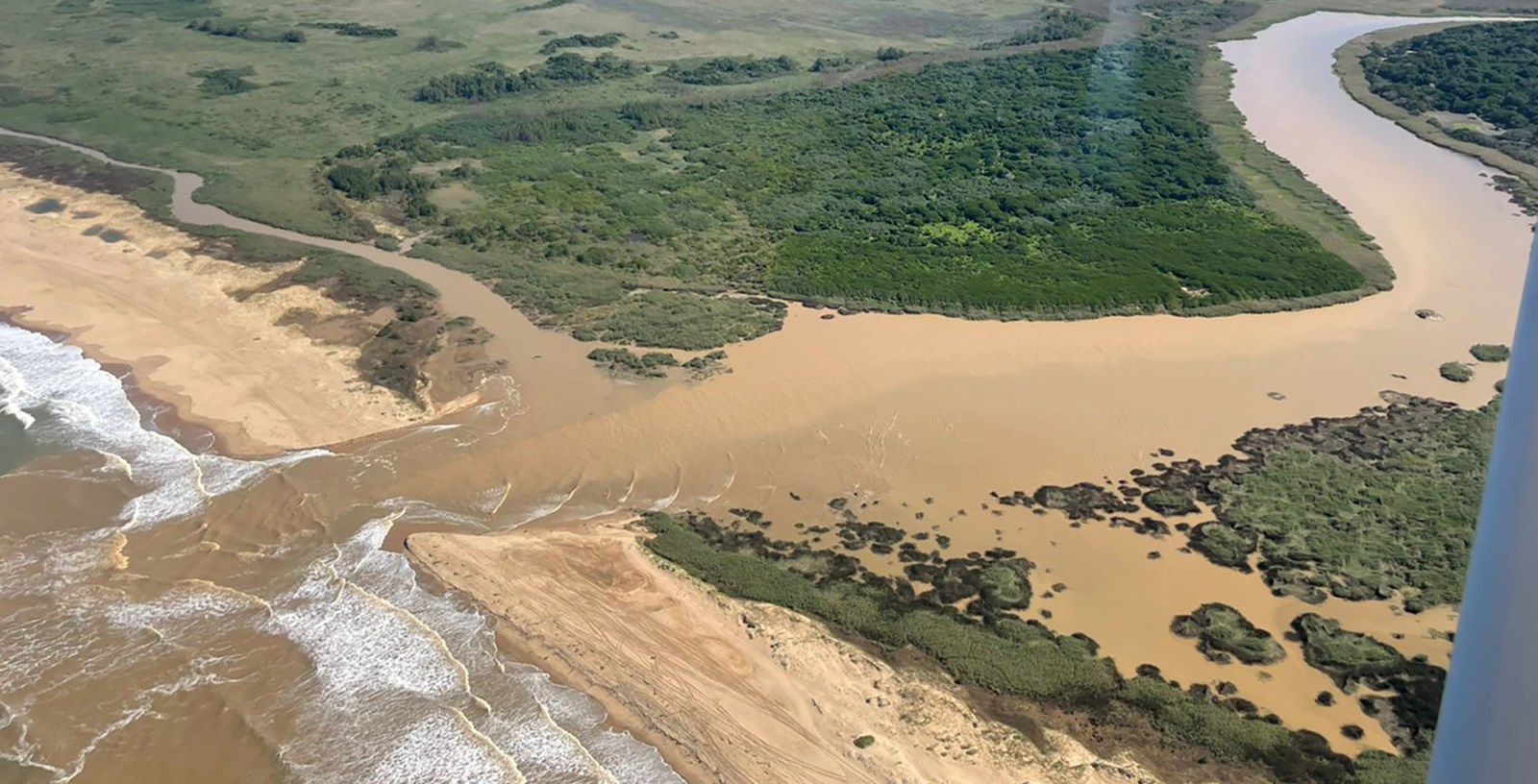
Floodwaters have opened the mouth of Lake St Lucia. (Photo: Chris Rattray Bateleurs / Flying for the Environment)
By Tony Carnie | 18 Apr 2022
Amid the human and economic tragedies wrought by the KZN floods, there was cause for some celebration last week when rising floodwaters broke open the mouth of the Lake St Lucia estuary.
_______________________________________________________________________________________________________________________
It may seem strange for so much attention to be given to whether a river estuary is open or shut – even if it is the largest in South Africa, in the heart of a World Heritage Site.
But this shallow 70km-long lake system is no ordinary water body. For centuries, it has been shaped by whether the water is salty, fresh, or somewhere in between these two extremes.
These altered states between hyper-salinity and freshwater – as well as the volume of water in the lake – exert complex ripple effects on the natural ecology and the associated pressure cooker of steady human population growth and commerce in the surrounding region.
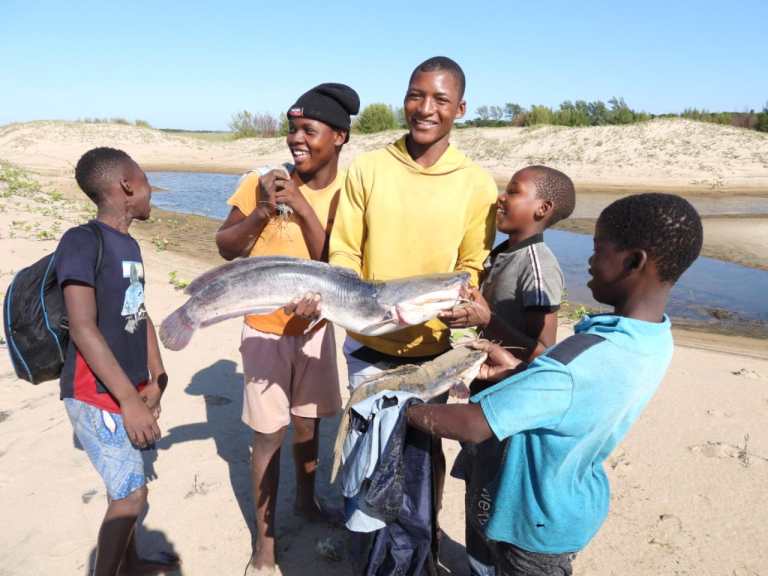
These youngsters used their hands to scoop up barbel and other fish that washed out of the lake mouth last week. (Photo: Ezemvelo)
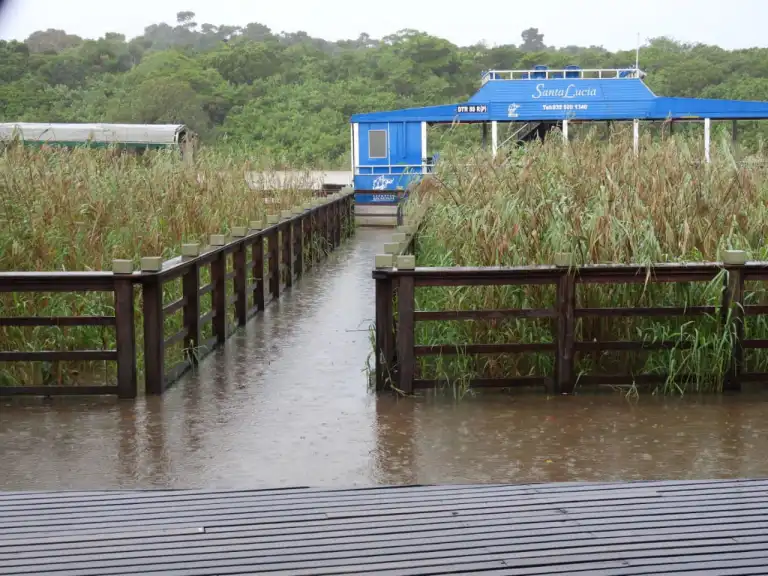
Concealed by dense reeds, the Santa Lucia tour boat awaits passengers shortly before the mouth broke open. (Photo: Ezemvelo)
For roughly 70 years, park managers and other interest groups have sought to re-engineer this complex hydrological environment to achieve some form of social and environmental “stability” – but nature is powerful and unpredictable.
And nature intervened once more in the early hours of April 14 when a major pulse of floodwater broke open the mouth to allow seawater and freshwater to mix things up once more.
It certainly wasn’t the massive jackhammer of water that many hoped would miraculously flush away the rising social tension and the decades-old accumulation of muddy sediments that has been building up around the mouth of this globally significant wetland system.
Nevertheless, it was as if a cork had been released from the neck of a massive bottle, allowing the roiling waters of the Umfolozi River and the lake to re-enter the Indian Ocean.
The lifting of this vital pressure-relief valve has also provided some breathing space – albeit temporary – for iSimangaliso Wetland Park conservation managers to address the increasing clamour by farmers, local tourist operations and saltwater anglers who favour the resumption of regular, artificial breaching of the lake mouth.
One example of the social ripple effects emerged last month when several hundred people attempted to invade the Futululu forest section of the park.
Though many were “opportunists” hoping to grab a cheap plot of land, the occupation attempt in the Unesco World Heritage Site was partly driven by subsistence farmers whose plots along the Umfolozi River floodplain have been inundated by water, which backed up into their plots because the river water could not break through to the sea.
Now that the “cork” (the sandbar at the joint river mouth of the Umfolozi and Lake St Lucia) has been removed, the high levels of freshwater in the river floodplain and in the lake will start to recede from the floodplain.
As the sodden land dries out, those farmers driving the illegal occupation at Futululu can now return to their flood-prone plots next to the Umfolozi.
The natural opening of the mouth also increases the likelihood that seawater can re-enter the lake estuary, bringing in more of the saltwater fish species that many anglers favour over freshwater species such as tilapia or barbel.
Large stands of freshwater riverine reeds that have proliferated near the mouth may also begin to die off naturally as they cannot tolerate very salty water conditions.
However, at least two big questions remain: How long will the mouth remain open? And will this natural breaching be sufficient to scour away tons of muddy sediments (and sea-driven beach sand) that have hampered navigation and wildlife viewing by several boat-based tourism operators?
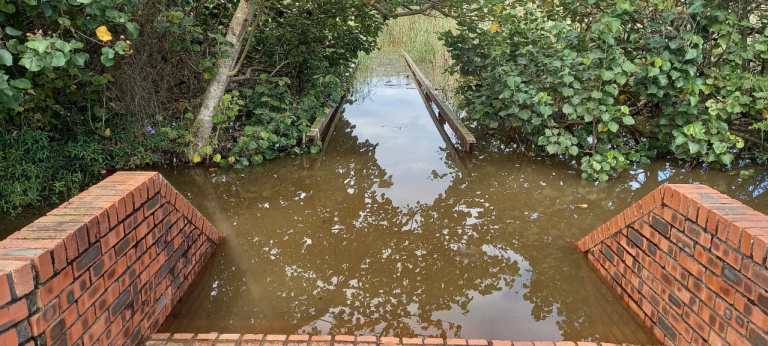
Due to rising floodwaters, the Sugar Loaf jetty was flooded until the mouth broke open. (Photo: Ezemvelo)
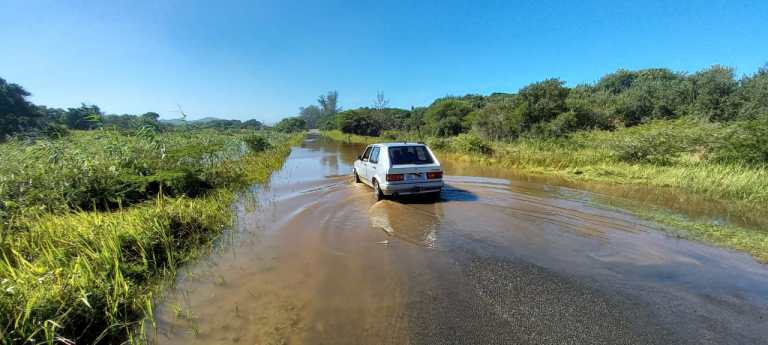
Several roads in the iSimangaliso Wetlland Park were impassable last week due to floodwaters. (Photo: Ezemvelo)
Dr Ricky Taylor, a retired park ecologist who has spent several decades observing the fluctuations of the lake, said: “I am delighted with the breaching of St Lucia. My hope is that a lot of sediment will scour from the system and the mouth will stay open for long enough for saltwater to enter to re-establish estuarine conditions.”
But he also fears that – despite the high volume of rain that fell along the coastline last week – it was “quite a small flood” when compared to previous storms that were driven by larger volumes of water from higher up in the Umfolozi River’s catchment area.
Taylor notes that muddy rivers drop their loads of sediment as they approach the sea and lake. Over time those fine sediments become compacted and “almost immovable” unless there is a massive pulse of floodwater.
“I am a bit pessimistic about how much [sediment] will be flushed out this time – but I have not seen any of the hydrological or sediment monitoring data yet,” said Taylor.
In 2011, based on a scientific re-evaluation of past human intervention, iSimangaliso took a policy decision to begin restoring the natural hydrological and ecological functioning of the lake system – essentially leaving things to nature, rather than regular human and engineering interventions.
Crucially, the park authority decided to allow the Umfolozi River to revert to its natural course to allow more freshwater to flow into the lake – a significant reversal of the previous policy of deliberately separating the Umfolozi from the lake since the 1950s.
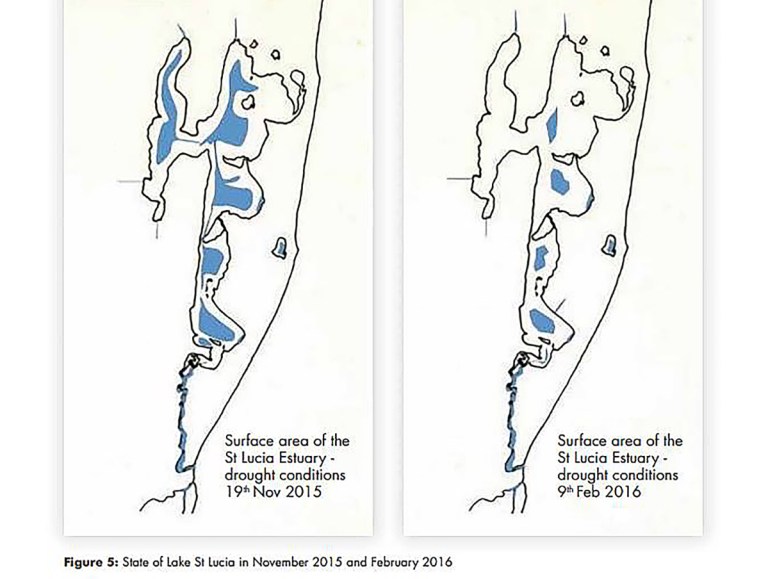
Lake St Lucia was almost bone dry during the 2014-2016 drought, with its shallow lake bed filled with the bones of dead fish. (Source: Ezemvelo)
Studies suggest that this river once provided nearly 60% of the lake’s freshwater flow and it was therefore crucial to restore that hydrological umbilical cord.
While several sugar farmers opposed that decision, they lost their case in the high court and Supreme Court of Appeal.
Since then, more water from the Umfolozi has returned to the lake – but the high volumes of muddy sediments from that river have also raised the ire of many other interest groups who favour the resumption of engineering solutions to keep the mouth open by artificial breaching and dredging.
In January 2020, iSimangaliso bowed to this pressure and allowed the mouth to be breached artificially using mechanical equipment.
While the park managers were praised by those interest groups in favour of deliberate management of the mouth, a group of estuarine scientists and other conservation groups condemned the artificial breaching.
In a letter to Forestry, Fisheries and Environment Minister Barbara Creecy, the scientists asked for an explanation on who authorised the policy flip-flop on artificially breaching the Lake St Lucia mouth.
The seven scientists – Professor Anthony “Ticky” Forbes, Nicolette Forbes, Professor Derek Stretch, Dr Barry Clark, Dr Jane Turpie, Eddie Bosman and Professor Gerrit Basson – said iSimangaliso “seems to have abandoned its own management strategy and ignored the scientific evidence on which this strategy is based”.
In response, Creecy appointed an expert panel to advise the government on what should be done to manage the mouth management conundrum.
It is chaired by Stellenbosch University aquatic ecologist Dr Nasreen Peer. The other panel members are Derek Stretch, Bonani Madikizela, Sibusiso Ngcobo and Lindile Ndbeni.
By coincidence, on April 14, the same day that nature intervened to reopen the mouth, Creecy announced that she had received the panel’s findings and recommendations “and will make the report and its recommendations public in the near future”.
Given the heated public controversy and polarised views on what should be done, it seems inevitable that the panel recommendations will be contentious either way. DM/OBP

Floodwaters have opened the mouth of Lake St Lucia. (Photo: Chris Rattray Bateleurs / Flying for the Environment)
By Tony Carnie | 18 Apr 2022
Amid the human and economic tragedies wrought by the KZN floods, there was cause for some celebration last week when rising floodwaters broke open the mouth of the Lake St Lucia estuary.
_______________________________________________________________________________________________________________________
It may seem strange for so much attention to be given to whether a river estuary is open or shut – even if it is the largest in South Africa, in the heart of a World Heritage Site.
But this shallow 70km-long lake system is no ordinary water body. For centuries, it has been shaped by whether the water is salty, fresh, or somewhere in between these two extremes.
These altered states between hyper-salinity and freshwater – as well as the volume of water in the lake – exert complex ripple effects on the natural ecology and the associated pressure cooker of steady human population growth and commerce in the surrounding region.

These youngsters used their hands to scoop up barbel and other fish that washed out of the lake mouth last week. (Photo: Ezemvelo)

Concealed by dense reeds, the Santa Lucia tour boat awaits passengers shortly before the mouth broke open. (Photo: Ezemvelo)
For roughly 70 years, park managers and other interest groups have sought to re-engineer this complex hydrological environment to achieve some form of social and environmental “stability” – but nature is powerful and unpredictable.
And nature intervened once more in the early hours of April 14 when a major pulse of floodwater broke open the mouth to allow seawater and freshwater to mix things up once more.
It certainly wasn’t the massive jackhammer of water that many hoped would miraculously flush away the rising social tension and the decades-old accumulation of muddy sediments that has been building up around the mouth of this globally significant wetland system.
Nevertheless, it was as if a cork had been released from the neck of a massive bottle, allowing the roiling waters of the Umfolozi River and the lake to re-enter the Indian Ocean.
The lifting of this vital pressure-relief valve has also provided some breathing space – albeit temporary – for iSimangaliso Wetland Park conservation managers to address the increasing clamour by farmers, local tourist operations and saltwater anglers who favour the resumption of regular, artificial breaching of the lake mouth.
One example of the social ripple effects emerged last month when several hundred people attempted to invade the Futululu forest section of the park.
Though many were “opportunists” hoping to grab a cheap plot of land, the occupation attempt in the Unesco World Heritage Site was partly driven by subsistence farmers whose plots along the Umfolozi River floodplain have been inundated by water, which backed up into their plots because the river water could not break through to the sea.
Now that the “cork” (the sandbar at the joint river mouth of the Umfolozi and Lake St Lucia) has been removed, the high levels of freshwater in the river floodplain and in the lake will start to recede from the floodplain.
As the sodden land dries out, those farmers driving the illegal occupation at Futululu can now return to their flood-prone plots next to the Umfolozi.
The natural opening of the mouth also increases the likelihood that seawater can re-enter the lake estuary, bringing in more of the saltwater fish species that many anglers favour over freshwater species such as tilapia or barbel.
Large stands of freshwater riverine reeds that have proliferated near the mouth may also begin to die off naturally as they cannot tolerate very salty water conditions.
However, at least two big questions remain: How long will the mouth remain open? And will this natural breaching be sufficient to scour away tons of muddy sediments (and sea-driven beach sand) that have hampered navigation and wildlife viewing by several boat-based tourism operators?

Due to rising floodwaters, the Sugar Loaf jetty was flooded until the mouth broke open. (Photo: Ezemvelo)

Several roads in the iSimangaliso Wetlland Park were impassable last week due to floodwaters. (Photo: Ezemvelo)
Dr Ricky Taylor, a retired park ecologist who has spent several decades observing the fluctuations of the lake, said: “I am delighted with the breaching of St Lucia. My hope is that a lot of sediment will scour from the system and the mouth will stay open for long enough for saltwater to enter to re-establish estuarine conditions.”
But he also fears that – despite the high volume of rain that fell along the coastline last week – it was “quite a small flood” when compared to previous storms that were driven by larger volumes of water from higher up in the Umfolozi River’s catchment area.
Taylor notes that muddy rivers drop their loads of sediment as they approach the sea and lake. Over time those fine sediments become compacted and “almost immovable” unless there is a massive pulse of floodwater.
“I am a bit pessimistic about how much [sediment] will be flushed out this time – but I have not seen any of the hydrological or sediment monitoring data yet,” said Taylor.
In 2011, based on a scientific re-evaluation of past human intervention, iSimangaliso took a policy decision to begin restoring the natural hydrological and ecological functioning of the lake system – essentially leaving things to nature, rather than regular human and engineering interventions.
Crucially, the park authority decided to allow the Umfolozi River to revert to its natural course to allow more freshwater to flow into the lake – a significant reversal of the previous policy of deliberately separating the Umfolozi from the lake since the 1950s.

Lake St Lucia was almost bone dry during the 2014-2016 drought, with its shallow lake bed filled with the bones of dead fish. (Source: Ezemvelo)
Studies suggest that this river once provided nearly 60% of the lake’s freshwater flow and it was therefore crucial to restore that hydrological umbilical cord.
While several sugar farmers opposed that decision, they lost their case in the high court and Supreme Court of Appeal.
Since then, more water from the Umfolozi has returned to the lake – but the high volumes of muddy sediments from that river have also raised the ire of many other interest groups who favour the resumption of engineering solutions to keep the mouth open by artificial breaching and dredging.
In January 2020, iSimangaliso bowed to this pressure and allowed the mouth to be breached artificially using mechanical equipment.
While the park managers were praised by those interest groups in favour of deliberate management of the mouth, a group of estuarine scientists and other conservation groups condemned the artificial breaching.
In a letter to Forestry, Fisheries and Environment Minister Barbara Creecy, the scientists asked for an explanation on who authorised the policy flip-flop on artificially breaching the Lake St Lucia mouth.
The seven scientists – Professor Anthony “Ticky” Forbes, Nicolette Forbes, Professor Derek Stretch, Dr Barry Clark, Dr Jane Turpie, Eddie Bosman and Professor Gerrit Basson – said iSimangaliso “seems to have abandoned its own management strategy and ignored the scientific evidence on which this strategy is based”.
In response, Creecy appointed an expert panel to advise the government on what should be done to manage the mouth management conundrum.
It is chaired by Stellenbosch University aquatic ecologist Dr Nasreen Peer. The other panel members are Derek Stretch, Bonani Madikizela, Sibusiso Ngcobo and Lindile Ndbeni.
By coincidence, on April 14, the same day that nature intervened to reopen the mouth, Creecy announced that she had received the panel’s findings and recommendations “and will make the report and its recommendations public in the near future”.
Given the heated public controversy and polarised views on what should be done, it seems inevitable that the panel recommendations will be contentious either way. DM/OBP
"Education is the most powerful weapon which you can use to change the world." Nelson Mandela
The desire for equality must never exceed the demands of knowledge
The desire for equality must never exceed the demands of knowledge
- Lisbeth
- Site Admin
- Posts: 67551
- Joined: Sat May 19, 2012 12:31 pm
- Country: Switzerland
- Location: Lugano
- Contact:
Re: Lake St Lucia Estuary Mouth Intervention
More artificial Lake St Lucia estuary breaches on the cards
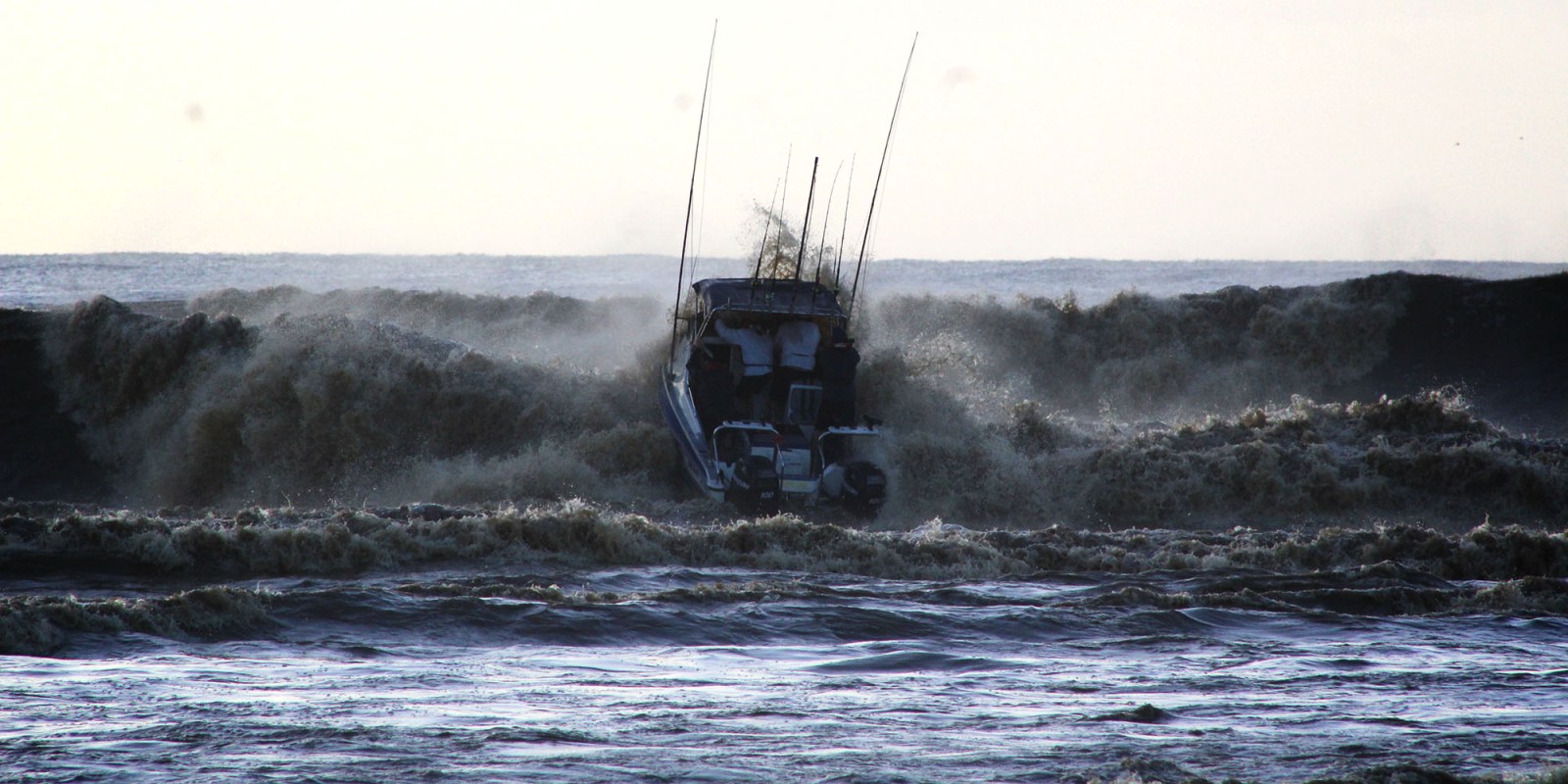
A ski-boat crew ploughs through the mud-stained surf at the mouth of the Lake St Lucia estuary on April 28. The prolonged closure and increasing build-up of muddy sediments and back-flooding of nearby farms have generated heated debates. (Photo: Tony Carnie)
By Tony Carnie | 28 Apr 2022
The government has opened the door to further artificial breaching of the Lake St Lucia estuary mouth and other short and longer-term measures to alleviate the flooding of subsistence farming plots and other social or economic impacts around the iSimangaliso Wetland Park.
_________________________________________________________________________________________________________________
The decision to sanction further “emergency” breaching of the mouth of South Africa’s largest estuary was announced in St Lucia village yesterday 28 April by Barbara Creecy, the national Minister of Forestry, Fisheries and Environment.
Creecy also released a 138-page report by an expert panel she appointed last year to investigate the controversial January 2021 decision by the iSimangaliso Wetland Park to artificially breach the mouth with earthmoving equipment.
While that decision was welcomed at the time by local commercial sugar farmers, subsistence crop farmers, anglers and other interest groups, it was slammed by several conservation groups and a group of seven estuarine scientists who described it as a major setback to recent attempts to restore the natural functioning of the 70km lake system after decades of human interference around the estuary.
The high court also ruled in 2018 that the mouth of the adjoining Umfolozi River could no longer be breached artificially to alleviate back-flooding of farms on the river floodplain.
The panel, chaired by marine biologist Dr Nasreen Peer, has now recommended that iSimangaliso should be allowed to continue artificial breaching under “emergency” conditions — though a clear definition of what constitutes an emergency or exceptional circumstances still has to be developed further.
However, this recommendation does not provide carte blanche to the park authorities to breach the mouth at will at the request of farmers or other groups who have been pushing for the mouth to be kept permanently open to the sea via artificial dredging and other means. Nor does it appear to be a complete reversal of more recent efforts to restore the natural functioning of the mouth as far as possible.
According to the panel report: “When emergency conditions develop demanding urgent breaching, some of the Estuarine Management Plan prescriptions can be waived (but compliance to National Environmental Management Act section 30 should never be waived), however this must be monitored constantly, and communicated to affected and interested stakeholders. A breaching report must be produced and form part of the annual reporting. It must carry as (much) detailed information as possible including motivation, and processes followed.”
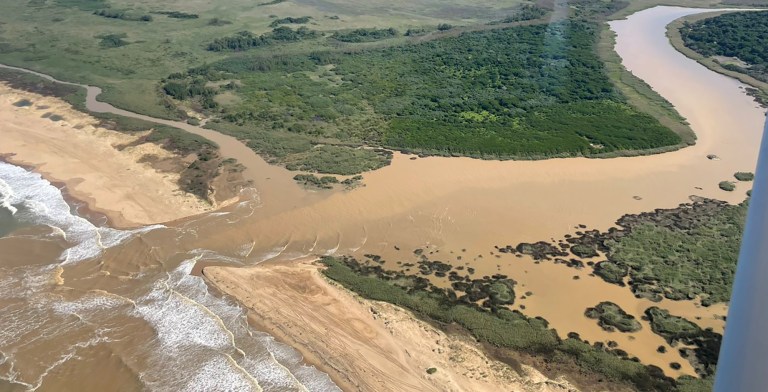
Floodwaters have opened the mouth of Lake St Lucia. (Photo: Chris Rattray Bateleurs / Flying for the Environment)
Though some farmers and the St Lucia Business Forum have welcomed the panel’s main decision to sanction further artificial breaching, Creecy nevertheless faced a barrage of criticism and demands for “immediate” action to drain more water from the Umfolozi floodplain by visibly angry subsistence farmers from the neighbouring Sokhulu, Dukuduku, Zwenelisha and Enkanini areas.
Many complained that their crops of bananas, potatoes, madumbes and other vegetables had been flooded on a regular basis over recent years due to the natural closure of the estuary mouth.
Creecy said the panel had reviewed relevant laws, management plans, advisory reports and other literature and also conducted site visits and met scientific experts, management authorities, amakhosi, farmers, fishers, tour operators, ratepayers, municipal staff and relevant government departments.
The review found that the breach was contrary to the Global Environment Facility (GEF) scientific team recommendations that no artificial breaching should occur.
However, iSimangaliso Wetland Park Authority had performed the artificial breaching “within the mandate as approved through their Maintenance Management Plan, authorised by the Department of Forestry, Fisheries and the Environment, and in line with the prescriptions of related legislation.”
The panel found many ecological reasons would justify the breach including the prolonged closure of the system from the sea — including the concern over accumulated sediment in the lake system; the presence of alien invasive species; a decrease in biodiversity within the system; and a decrease in the nursery function of the estuary.
“Importantly, the review is critical that the Estuarine Management Plan makes no mention of socio-economic factors in its definition of exceptional circumstances, despite several social and economic concerns associated with a prolonged closed mouth state.“
Not considering these socio-economic factors “contributed to community-conservation conflict in relation to the management of the mouth as most stakeholder groups seem to require the St Lucia system to function in one specific state”.
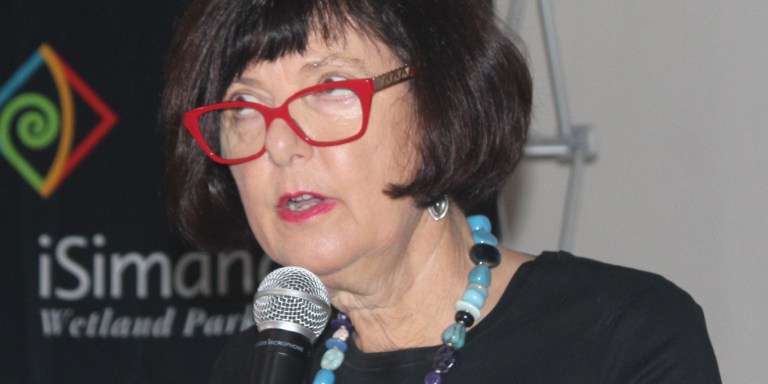
A panel appointed by Environment Minister Barbara Creecy has recommended that further artificial breaching of the estuary mouth should be sanctioned in ‘emergency or exceptional circumstances’. (Photo: Tony Carnie)
“However, it is important to note that St Lucia as a dynamic system cannot and should not be confined to one ideal state.”
Creecy said the panel also found that the artificial opening seemed to have had a positive effect on the restoration of the nursery function of the system and that a number of marine fish for tourism and recreational fishing had been reintroduced
It had recommended that maintenance breaching could continue in “exceptional circumstances”.
“However, the exceptional circumstances — ecological or social— for future maintenance breaching must be clearly defined before any further action. While it is clearly understood that the GEF report advises against breaching, it is practical and necessary to consider the effects of allowing the mouth to remain closed.”
As a result, the panel recommended that iSimangaliso develop and intensify an in-house monitoring plan and build the capacity to collect monitoring data. This should include both biodiversity monitoring and socio-economic data on the effects of the lake system function.
“The Panel notes that future breaching should not take place without adequate ecological monitoring before and after the event, to ensure the most efficient breach in terms of the intended objectives as well as potential socio-economic reasons. Continued intensive monitoring would also allow for a more adaptive management strategy which is more suitable for the dynamic St Lucia system.”
“To assist with relief to farmers in the uMfolozi-Msunduzi floodplain as a result of back-flooding, the report recommends clearing the Msunduzi and beach channel of vegetation and sediment to allow water to flow freely from the floodplain to the mouth. “
The panel further recommended “urgent improvement in communication between the management of Isimangaliso and stakeholders” including communities, to allow stakeholders to better understand management decisions. This should include translating technical documents into an easily understandable format.
“The Panel states that moving forward, it is clear that the St Lucia Lake, protected and managed by iSimangaliso Wetland Park Authority, can no longer be managed as an isolated system. Activities in the floodplain and catchment areas of the feeder rivers contribute to the health of the St Lucia system. As such, the Panel recommends the development of a comprehensive Reserve Determination of Ecological Water Requirements be developed.
“In conclusion, let me say once more that the Department and I are committed to offering solutions that will safeguard the heritage in iSimangaliso, while also supporting the livelihoods of communities in and around the Park.
“This report has to be the beginning of a new chapter of collaboration and working together in the sustainable management of the St Lucia estuary.”
The report is available on the Department of Forestry, Fisheries and the Environment website. DM/OBP

A ski-boat crew ploughs through the mud-stained surf at the mouth of the Lake St Lucia estuary on April 28. The prolonged closure and increasing build-up of muddy sediments and back-flooding of nearby farms have generated heated debates. (Photo: Tony Carnie)
By Tony Carnie | 28 Apr 2022
The government has opened the door to further artificial breaching of the Lake St Lucia estuary mouth and other short and longer-term measures to alleviate the flooding of subsistence farming plots and other social or economic impacts around the iSimangaliso Wetland Park.
_________________________________________________________________________________________________________________
The decision to sanction further “emergency” breaching of the mouth of South Africa’s largest estuary was announced in St Lucia village yesterday 28 April by Barbara Creecy, the national Minister of Forestry, Fisheries and Environment.
Creecy also released a 138-page report by an expert panel she appointed last year to investigate the controversial January 2021 decision by the iSimangaliso Wetland Park to artificially breach the mouth with earthmoving equipment.
While that decision was welcomed at the time by local commercial sugar farmers, subsistence crop farmers, anglers and other interest groups, it was slammed by several conservation groups and a group of seven estuarine scientists who described it as a major setback to recent attempts to restore the natural functioning of the 70km lake system after decades of human interference around the estuary.
The high court also ruled in 2018 that the mouth of the adjoining Umfolozi River could no longer be breached artificially to alleviate back-flooding of farms on the river floodplain.
The panel, chaired by marine biologist Dr Nasreen Peer, has now recommended that iSimangaliso should be allowed to continue artificial breaching under “emergency” conditions — though a clear definition of what constitutes an emergency or exceptional circumstances still has to be developed further.
However, this recommendation does not provide carte blanche to the park authorities to breach the mouth at will at the request of farmers or other groups who have been pushing for the mouth to be kept permanently open to the sea via artificial dredging and other means. Nor does it appear to be a complete reversal of more recent efforts to restore the natural functioning of the mouth as far as possible.
According to the panel report: “When emergency conditions develop demanding urgent breaching, some of the Estuarine Management Plan prescriptions can be waived (but compliance to National Environmental Management Act section 30 should never be waived), however this must be monitored constantly, and communicated to affected and interested stakeholders. A breaching report must be produced and form part of the annual reporting. It must carry as (much) detailed information as possible including motivation, and processes followed.”

Floodwaters have opened the mouth of Lake St Lucia. (Photo: Chris Rattray Bateleurs / Flying for the Environment)
Though some farmers and the St Lucia Business Forum have welcomed the panel’s main decision to sanction further artificial breaching, Creecy nevertheless faced a barrage of criticism and demands for “immediate” action to drain more water from the Umfolozi floodplain by visibly angry subsistence farmers from the neighbouring Sokhulu, Dukuduku, Zwenelisha and Enkanini areas.
Many complained that their crops of bananas, potatoes, madumbes and other vegetables had been flooded on a regular basis over recent years due to the natural closure of the estuary mouth.
Creecy said the panel had reviewed relevant laws, management plans, advisory reports and other literature and also conducted site visits and met scientific experts, management authorities, amakhosi, farmers, fishers, tour operators, ratepayers, municipal staff and relevant government departments.
The review found that the breach was contrary to the Global Environment Facility (GEF) scientific team recommendations that no artificial breaching should occur.
However, iSimangaliso Wetland Park Authority had performed the artificial breaching “within the mandate as approved through their Maintenance Management Plan, authorised by the Department of Forestry, Fisheries and the Environment, and in line with the prescriptions of related legislation.”
The panel found many ecological reasons would justify the breach including the prolonged closure of the system from the sea — including the concern over accumulated sediment in the lake system; the presence of alien invasive species; a decrease in biodiversity within the system; and a decrease in the nursery function of the estuary.
“Importantly, the review is critical that the Estuarine Management Plan makes no mention of socio-economic factors in its definition of exceptional circumstances, despite several social and economic concerns associated with a prolonged closed mouth state.“
Not considering these socio-economic factors “contributed to community-conservation conflict in relation to the management of the mouth as most stakeholder groups seem to require the St Lucia system to function in one specific state”.

A panel appointed by Environment Minister Barbara Creecy has recommended that further artificial breaching of the estuary mouth should be sanctioned in ‘emergency or exceptional circumstances’. (Photo: Tony Carnie)
“However, it is important to note that St Lucia as a dynamic system cannot and should not be confined to one ideal state.”
Creecy said the panel also found that the artificial opening seemed to have had a positive effect on the restoration of the nursery function of the system and that a number of marine fish for tourism and recreational fishing had been reintroduced
It had recommended that maintenance breaching could continue in “exceptional circumstances”.
“However, the exceptional circumstances — ecological or social— for future maintenance breaching must be clearly defined before any further action. While it is clearly understood that the GEF report advises against breaching, it is practical and necessary to consider the effects of allowing the mouth to remain closed.”
As a result, the panel recommended that iSimangaliso develop and intensify an in-house monitoring plan and build the capacity to collect monitoring data. This should include both biodiversity monitoring and socio-economic data on the effects of the lake system function.
“The Panel notes that future breaching should not take place without adequate ecological monitoring before and after the event, to ensure the most efficient breach in terms of the intended objectives as well as potential socio-economic reasons. Continued intensive monitoring would also allow for a more adaptive management strategy which is more suitable for the dynamic St Lucia system.”
“To assist with relief to farmers in the uMfolozi-Msunduzi floodplain as a result of back-flooding, the report recommends clearing the Msunduzi and beach channel of vegetation and sediment to allow water to flow freely from the floodplain to the mouth. “
The panel further recommended “urgent improvement in communication between the management of Isimangaliso and stakeholders” including communities, to allow stakeholders to better understand management decisions. This should include translating technical documents into an easily understandable format.
“The Panel states that moving forward, it is clear that the St Lucia Lake, protected and managed by iSimangaliso Wetland Park Authority, can no longer be managed as an isolated system. Activities in the floodplain and catchment areas of the feeder rivers contribute to the health of the St Lucia system. As such, the Panel recommends the development of a comprehensive Reserve Determination of Ecological Water Requirements be developed.
“In conclusion, let me say once more that the Department and I are committed to offering solutions that will safeguard the heritage in iSimangaliso, while also supporting the livelihoods of communities in and around the Park.
“This report has to be the beginning of a new chapter of collaboration and working together in the sustainable management of the St Lucia estuary.”
The report is available on the Department of Forestry, Fisheries and the Environment website. DM/OBP
"Education is the most powerful weapon which you can use to change the world." Nelson Mandela
The desire for equality must never exceed the demands of knowledge
The desire for equality must never exceed the demands of knowledge
- Lisbeth
- Site Admin
- Posts: 67551
- Joined: Sat May 19, 2012 12:31 pm
- Country: Switzerland
- Location: Lugano
- Contact:
Re: Lake St Lucia Estuary Mouth Intervention
Is artificial breaching a new chapter or an early sunset for the St Lucia estuary?
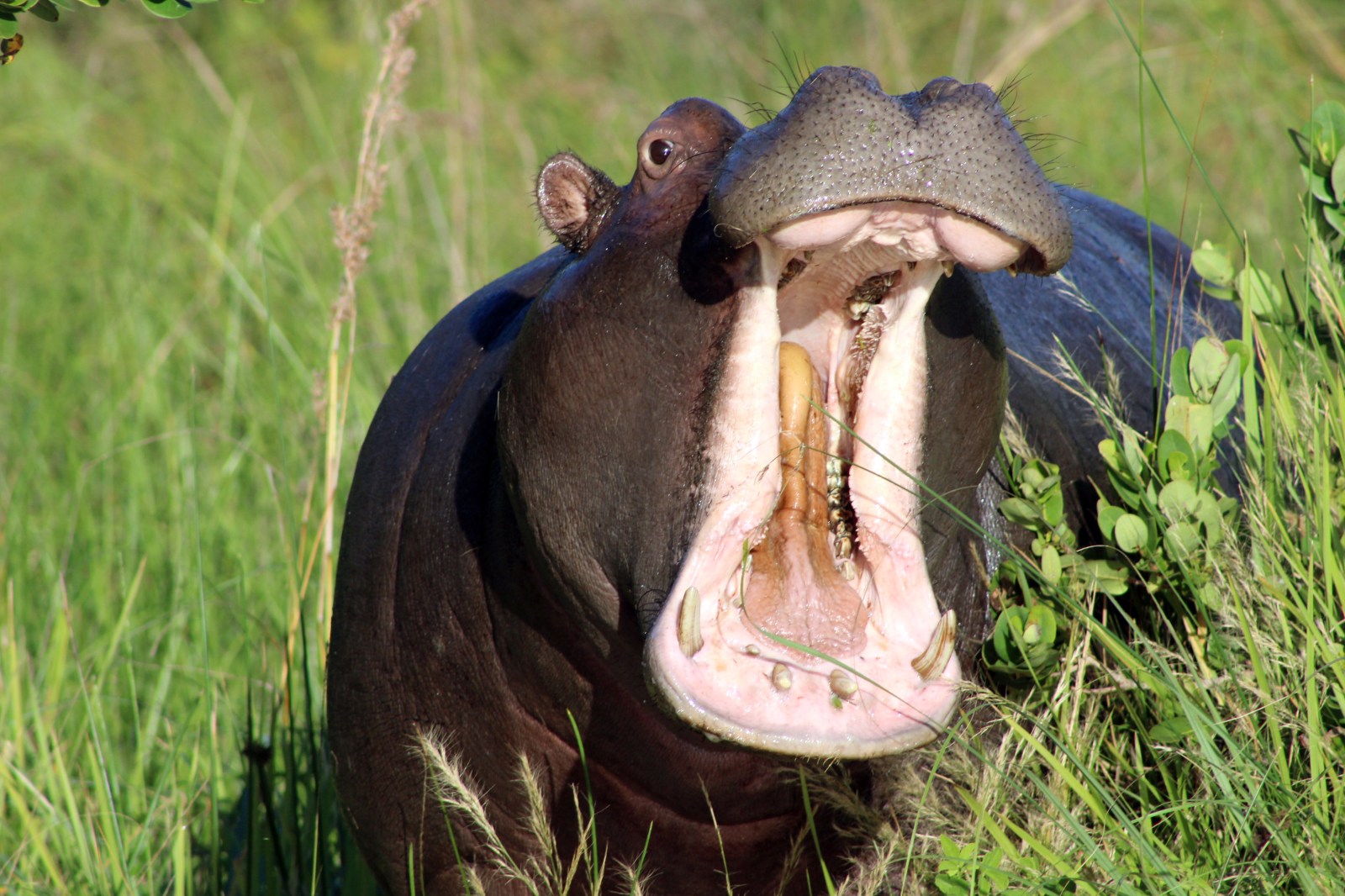
A young hippo bull shows its teeth to tour-boat visitors in the so-named Narrows section of Lake St Lucia. (Photo: Tony Carnie)
By Tony Carnie | 10 May 2022
With its history of becoming an enormous scrambled egg of interventions with often unpredictable results, the storied estuary has been the centre of one bout of controversy after another. Now, a new commitment to better manage ther estuary might prove easier said than done.
_____________________________________________________________________________________________________________________
River floodplains – by their very name and nature – have a nasty habit of getting flooded or waterlogged.
So there should be no surprise that large areas of farmland slap-bang in the Umfolozi River floodplain have been inundated by large volumes of water and mud over recent years.
If this large natural floodplain and major feeder river of Lake St Lucia had remained unmodified, many of the heated debates of the past century are unlikely to have arisen along the boundaries of the iSimangaliso Wetland Park in KwaZulu-Natal.
But, because floodplains are flat, wet and fertile, they are often magnets to farmers across the world.
This can be a recipe for disaster during the wet season or heavy floods. Yet, in northern KZN, where land remains in short supply for many displaced rural communities, subsistence farmers can’t be too picky about planting their bananas and vegetables in places prone to flooding.
From about 1911, the first commercial sugar farmers also began to occupy and drain parts of the lower Umfolozi swamplands. By 1937, they had taken over nearly 30% of the floodplain and kept expanding to occupy nearly half of it by the 1960s.
Sensibly, some farmers built their homes on high ground, often at quite some distance from their flood-prone fields. To protect crops and to access more of the boggy land, they dug deep canals to drain and divert water flow or they raised earth levees to reduce flood risks.
Gradually, these modifications changed the nature of the river from its long and meandering course (which once slowed down the water and spread out the silt load) into a shorter, straighter canal system with much muddier and faster-flowing water.
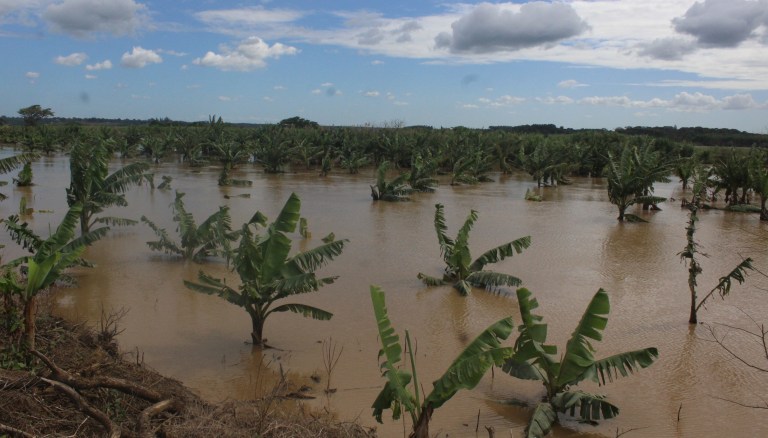
Extensive plantations of banana trees on the banks of the Umfolozi River have been submerged by high water levels. Picture Tony Carnie
By 1948, after a period of prolonged drought, the side-effects of this major land transformation next to Lake St Lucia were becoming increasingly evident. Water entering the lake was often choked with muddy sediments, while some farms were still being flooded from the more frequent closure of the joint mouths of Lake St Lucia and the Umfolozi and Msunduzi rivers.
In 1952, a decision was made to artificially separate the mouth of the Umfolozi from the lake estuary and divert it to flow directly into the sea near the tall coastal dunes of Maphelane.
This suited many farmers, but almost overnight the lake lost nearly 60% of its former water inflow and the estuary mouth began to close up from the sea more often.
One intervention led to another. With less freshwater entering St Lucia, the lake became increasingly salty during dry spells. At times, St Lucia lake water was three times saltier than the ocean and this began to threaten the survival of hippo, crocodiles, fish and other aquatic life. Cyclones and floods also pulverised or demolished some of the concrete and other engineered structures built to keep the mouth open.
In short, it was becoming an enormous scrambled egg of interventions with often unpredictable results.
Finally, in 2002, after decades of human interference, the St Lucia mouth was allowed to close naturally. In 2015, a group of estuarine researchers produced a report funded via the Global Environment Facility (GEF) recommending a new ecologically based restoration plan that included reconnecting the Umfolozi River to the lake.
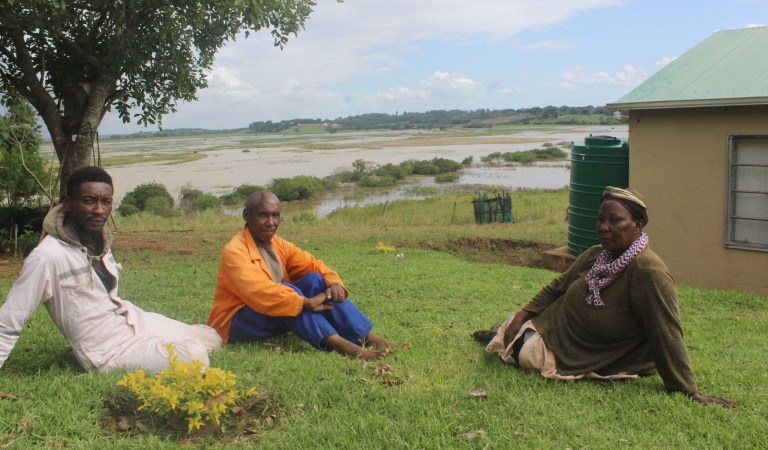
The Shongwe family (from left), Inkosikhona, Joseph and Rasta, used to live in the Mkhuze area but settled at the new Enkanini settlement near Dukuduku forest in 2010. Over recent years, however, their fields of potatoes, onions, cabbage and madumbes have been submerged by the frequent inundation of floodwaters in the Umfolozi River floodplain. (Photo: Tony Carnie)
The sugar farmers, concerned about renewed flood risks, fought back against this plan but lost their case in both the high court and Supreme Court of Appeal.
Soon after the Umfolozi was reconnected to the lake via a new beach channel, fresh criticism emerged from several interest groups who favoured a return to artificial engineering solutions to keep the St Lucia estuary more or less permanently open to the sea.
They included saltwater anglers, tour operators and a large number of subsistence farmers from the Umfolozi floodplain, and the Sokhulu community who farm along the Msunduzi River floodplain.
Following increasing social pressures and a workshop attended by a wide variety of stakeholders, the iSimangaliso Wetland Park authorities hired a private contractor to breach the lake mouth artificially in January 2021 – after a prolonged six-year mouth closure.
But this artificial breaching led to another bout of controversy between those for and against artificial breaching. Forestry, Fisheries and Environment Minister Barbara Creecy appointed a panel of experts to advise whether the breach was conducted legally; the impact and significance of this breaching event and to also develop guidelines for the future management of the lake system.
The five-member panel, chaired by marine biologist Dr Nasreen Peer, presented its 138-page report to Creecy last month and the findings and recommendations were made public at a meeting at St Lucia Eco Lodge on 28 April.
In a nutshell, the panel found that the decision to breach the mouth artificially directly contravened the GEF project recommendations – but that the park authorities had nevertheless acted “within the mandate” of an approved maintenance and management plan, which permitted such breaches in “exceptional circumstances”.
“However, it remains to be proven if (iSimangaliso) complied to its well-outlined legislation and plans.”
The panel also queried whether iSimangaliso managers engaged with the Department of Water Affairs before breaching the mouth. It further questioned the timing of the breach and the lack of scientific monitoring data immediately before and after the event.
While the breaching was justified as an “emergency” intervention, these conditions were not clearly defined. This meant that the park’s management plan – which advocates a policy of minimum human interference in natural processes – was open to interpretation when further artificial breaching was considered.
Significantly, however, the panel has now opened the door for further artificial breaching if there are clearly defined, exceptional reasons to justify this on either ecological or socioeconomic grounds.
The panel also believed there was a major “gap” in park management plans, which failed to take sufficient consideration of social and economic impacts such as flooding of farmland.
This, the panel cautioned, could only exacerbate conflict between park managers and community stakeholders.
To alleviate this conflict, the report recommends that more efforts be made to clear away the dense build-up of reeds and muddy sediment in the Msunduzi River channels that have led to flooding near Sokhulu.
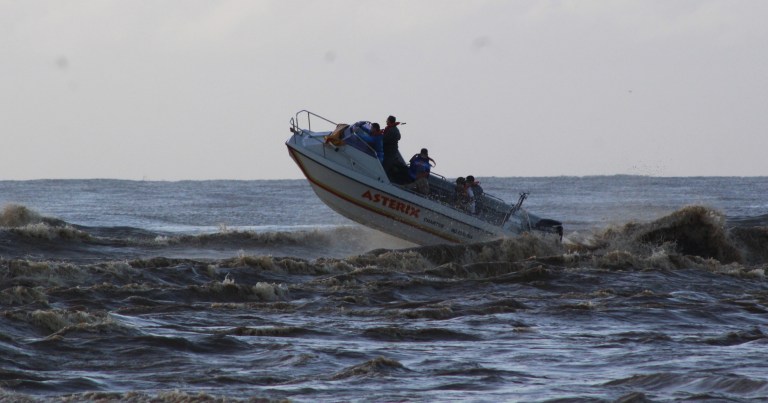
A skiboat crew heads out to sea from the mouth of the Lake St Lucia estuary during the recent Rosebowl deep-sea fishing tournament. (Photo: Tony Carnie)
St Lucia could also no longer be managed in isolation and there was a need to involve several other government authorities (including the national water, agriculture and land affairs departments and municipalities).
Accepting the report, Creecy voiced optimism and said she was committed to guarding the natural heritage of iSimangaliso, while also supporting the livelihoods of communities around the park: “This report has to be the beginning of a new chapter of collaboration and working together in the sustainable management of the St Lucia estuary.”
But opening this brighter new chapter is easier said than done, given the significant levels of conflict that have emerged over management of the mouth.
Subsistence farmers from the Dukuduku, Khula, Zwenelisha, Enkanini and Sokhulu areas have demanded “immediate action” to reduce water levels in the Umfolozi and Msunduzi floodplains. Last month, several hundred local residents – and outsiders – invaded the Futululu forest section of the park in search of new farmlands and housing plots.
Tour operators are also dismayed by the thick accumulations of mud and reed growth near the village of St Lucia that have apparently led to reduced sightings of crocodiles and hippos.
Dukuduku traditional council representative Mjonjani Gumede told Creecy that large numbers of people in the area rely on agriculture to feed their families and they would remain frustrated and angry unless they saw water receding from their flooded fields.
Sokhulu farmers representative Petros Mlaba said his members did not want to read more reports. They wanted action “today”.
“We survive from our fields but now we are overcrowded,” complained Ntokozo Sithole from Dukuduku. “We need space and the minister must not prioritise animals over us.”
Another local community representative told Creecy he was afraid to report back to his people unless he could reassure them and give them hope that water in their fields would drain quickly.
There has also been strong criticism of the current ecological management of the park and the GEF restoration project.
In his submission to the panel, former park ecologist Dr Ricky Taylor said he was concerned that the St Lucia lake system was on the verge of “flipping” irreversibly from an estuary into a shallow freshwater lake – possibly within a decade if the high silt levels entering the lake were not managed urgently.
The effects on sugar farmers, the displacement of people in the Sokhulu area and the flooding of subsistence farms in the Umfolozi floodplain had also not been sufficiently considered by the GEF programme.
“Although I am critical of the GEF management strategy, whenever I was asked my opinion I always responded that we should give it a chance to see if it works or not,” said Taylor.
“My attitude changed radically in September 2020 when I saw the sediment accumulations and associated vegetation responses, learnt about the flooding of the Umfolozi floodplain by backing up of water, and found out that almost no monitoring or assessment to this intervention was being done. There were (in my opinion) irreversible changes occurring and nobody was tracking the effectiveness, or otherwise, of the GEF management strategy.”
In Taylor’s view, it will now become necessary to intervene frequently to maintain St Lucia as a functional estuary – and this should include dredging and artificial breaching based on sound scientific advice.
While it was necessary to “salvage the essentials of the GEF strategy” to relink the Umfolozi to Lake St Lucia, the recent increase in muddy sediment loads had to be reversed, ideally through further international and other forms of funding assistance.
“We cannot implement a management strategy that relies on ‘natural processes’. There has been too much damage to the natural processes in the catchment and Umfolozi flats. We do need human interventions. These must be guided by competent people – who understand the area, have historical background, have experience and have the latest scientific knowledge,” Taylor concluded. DM/OBP

A young hippo bull shows its teeth to tour-boat visitors in the so-named Narrows section of Lake St Lucia. (Photo: Tony Carnie)
By Tony Carnie | 10 May 2022
With its history of becoming an enormous scrambled egg of interventions with often unpredictable results, the storied estuary has been the centre of one bout of controversy after another. Now, a new commitment to better manage ther estuary might prove easier said than done.
_____________________________________________________________________________________________________________________
River floodplains – by their very name and nature – have a nasty habit of getting flooded or waterlogged.
So there should be no surprise that large areas of farmland slap-bang in the Umfolozi River floodplain have been inundated by large volumes of water and mud over recent years.
If this large natural floodplain and major feeder river of Lake St Lucia had remained unmodified, many of the heated debates of the past century are unlikely to have arisen along the boundaries of the iSimangaliso Wetland Park in KwaZulu-Natal.
But, because floodplains are flat, wet and fertile, they are often magnets to farmers across the world.
This can be a recipe for disaster during the wet season or heavy floods. Yet, in northern KZN, where land remains in short supply for many displaced rural communities, subsistence farmers can’t be too picky about planting their bananas and vegetables in places prone to flooding.
From about 1911, the first commercial sugar farmers also began to occupy and drain parts of the lower Umfolozi swamplands. By 1937, they had taken over nearly 30% of the floodplain and kept expanding to occupy nearly half of it by the 1960s.
Sensibly, some farmers built their homes on high ground, often at quite some distance from their flood-prone fields. To protect crops and to access more of the boggy land, they dug deep canals to drain and divert water flow or they raised earth levees to reduce flood risks.
Gradually, these modifications changed the nature of the river from its long and meandering course (which once slowed down the water and spread out the silt load) into a shorter, straighter canal system with much muddier and faster-flowing water.

Extensive plantations of banana trees on the banks of the Umfolozi River have been submerged by high water levels. Picture Tony Carnie
By 1948, after a period of prolonged drought, the side-effects of this major land transformation next to Lake St Lucia were becoming increasingly evident. Water entering the lake was often choked with muddy sediments, while some farms were still being flooded from the more frequent closure of the joint mouths of Lake St Lucia and the Umfolozi and Msunduzi rivers.
In 1952, a decision was made to artificially separate the mouth of the Umfolozi from the lake estuary and divert it to flow directly into the sea near the tall coastal dunes of Maphelane.
This suited many farmers, but almost overnight the lake lost nearly 60% of its former water inflow and the estuary mouth began to close up from the sea more often.
One intervention led to another. With less freshwater entering St Lucia, the lake became increasingly salty during dry spells. At times, St Lucia lake water was three times saltier than the ocean and this began to threaten the survival of hippo, crocodiles, fish and other aquatic life. Cyclones and floods also pulverised or demolished some of the concrete and other engineered structures built to keep the mouth open.
In short, it was becoming an enormous scrambled egg of interventions with often unpredictable results.
Finally, in 2002, after decades of human interference, the St Lucia mouth was allowed to close naturally. In 2015, a group of estuarine researchers produced a report funded via the Global Environment Facility (GEF) recommending a new ecologically based restoration plan that included reconnecting the Umfolozi River to the lake.

The Shongwe family (from left), Inkosikhona, Joseph and Rasta, used to live in the Mkhuze area but settled at the new Enkanini settlement near Dukuduku forest in 2010. Over recent years, however, their fields of potatoes, onions, cabbage and madumbes have been submerged by the frequent inundation of floodwaters in the Umfolozi River floodplain. (Photo: Tony Carnie)
The sugar farmers, concerned about renewed flood risks, fought back against this plan but lost their case in both the high court and Supreme Court of Appeal.
Soon after the Umfolozi was reconnected to the lake via a new beach channel, fresh criticism emerged from several interest groups who favoured a return to artificial engineering solutions to keep the St Lucia estuary more or less permanently open to the sea.
They included saltwater anglers, tour operators and a large number of subsistence farmers from the Umfolozi floodplain, and the Sokhulu community who farm along the Msunduzi River floodplain.
Following increasing social pressures and a workshop attended by a wide variety of stakeholders, the iSimangaliso Wetland Park authorities hired a private contractor to breach the lake mouth artificially in January 2021 – after a prolonged six-year mouth closure.
But this artificial breaching led to another bout of controversy between those for and against artificial breaching. Forestry, Fisheries and Environment Minister Barbara Creecy appointed a panel of experts to advise whether the breach was conducted legally; the impact and significance of this breaching event and to also develop guidelines for the future management of the lake system.
The five-member panel, chaired by marine biologist Dr Nasreen Peer, presented its 138-page report to Creecy last month and the findings and recommendations were made public at a meeting at St Lucia Eco Lodge on 28 April.
In a nutshell, the panel found that the decision to breach the mouth artificially directly contravened the GEF project recommendations – but that the park authorities had nevertheless acted “within the mandate” of an approved maintenance and management plan, which permitted such breaches in “exceptional circumstances”.
“However, it remains to be proven if (iSimangaliso) complied to its well-outlined legislation and plans.”
The panel also queried whether iSimangaliso managers engaged with the Department of Water Affairs before breaching the mouth. It further questioned the timing of the breach and the lack of scientific monitoring data immediately before and after the event.
While the breaching was justified as an “emergency” intervention, these conditions were not clearly defined. This meant that the park’s management plan – which advocates a policy of minimum human interference in natural processes – was open to interpretation when further artificial breaching was considered.
Significantly, however, the panel has now opened the door for further artificial breaching if there are clearly defined, exceptional reasons to justify this on either ecological or socioeconomic grounds.
The panel also believed there was a major “gap” in park management plans, which failed to take sufficient consideration of social and economic impacts such as flooding of farmland.
This, the panel cautioned, could only exacerbate conflict between park managers and community stakeholders.
To alleviate this conflict, the report recommends that more efforts be made to clear away the dense build-up of reeds and muddy sediment in the Msunduzi River channels that have led to flooding near Sokhulu.

A skiboat crew heads out to sea from the mouth of the Lake St Lucia estuary during the recent Rosebowl deep-sea fishing tournament. (Photo: Tony Carnie)
St Lucia could also no longer be managed in isolation and there was a need to involve several other government authorities (including the national water, agriculture and land affairs departments and municipalities).
Accepting the report, Creecy voiced optimism and said she was committed to guarding the natural heritage of iSimangaliso, while also supporting the livelihoods of communities around the park: “This report has to be the beginning of a new chapter of collaboration and working together in the sustainable management of the St Lucia estuary.”
But opening this brighter new chapter is easier said than done, given the significant levels of conflict that have emerged over management of the mouth.
Subsistence farmers from the Dukuduku, Khula, Zwenelisha, Enkanini and Sokhulu areas have demanded “immediate action” to reduce water levels in the Umfolozi and Msunduzi floodplains. Last month, several hundred local residents – and outsiders – invaded the Futululu forest section of the park in search of new farmlands and housing plots.
Tour operators are also dismayed by the thick accumulations of mud and reed growth near the village of St Lucia that have apparently led to reduced sightings of crocodiles and hippos.
Dukuduku traditional council representative Mjonjani Gumede told Creecy that large numbers of people in the area rely on agriculture to feed their families and they would remain frustrated and angry unless they saw water receding from their flooded fields.
Sokhulu farmers representative Petros Mlaba said his members did not want to read more reports. They wanted action “today”.
“We survive from our fields but now we are overcrowded,” complained Ntokozo Sithole from Dukuduku. “We need space and the minister must not prioritise animals over us.”
Another local community representative told Creecy he was afraid to report back to his people unless he could reassure them and give them hope that water in their fields would drain quickly.
There has also been strong criticism of the current ecological management of the park and the GEF restoration project.
In his submission to the panel, former park ecologist Dr Ricky Taylor said he was concerned that the St Lucia lake system was on the verge of “flipping” irreversibly from an estuary into a shallow freshwater lake – possibly within a decade if the high silt levels entering the lake were not managed urgently.
The effects on sugar farmers, the displacement of people in the Sokhulu area and the flooding of subsistence farms in the Umfolozi floodplain had also not been sufficiently considered by the GEF programme.
“Although I am critical of the GEF management strategy, whenever I was asked my opinion I always responded that we should give it a chance to see if it works or not,” said Taylor.
“My attitude changed radically in September 2020 when I saw the sediment accumulations and associated vegetation responses, learnt about the flooding of the Umfolozi floodplain by backing up of water, and found out that almost no monitoring or assessment to this intervention was being done. There were (in my opinion) irreversible changes occurring and nobody was tracking the effectiveness, or otherwise, of the GEF management strategy.”
In Taylor’s view, it will now become necessary to intervene frequently to maintain St Lucia as a functional estuary – and this should include dredging and artificial breaching based on sound scientific advice.
While it was necessary to “salvage the essentials of the GEF strategy” to relink the Umfolozi to Lake St Lucia, the recent increase in muddy sediment loads had to be reversed, ideally through further international and other forms of funding assistance.
“We cannot implement a management strategy that relies on ‘natural processes’. There has been too much damage to the natural processes in the catchment and Umfolozi flats. We do need human interventions. These must be guided by competent people – who understand the area, have historical background, have experience and have the latest scientific knowledge,” Taylor concluded. DM/OBP
"Education is the most powerful weapon which you can use to change the world." Nelson Mandela
The desire for equality must never exceed the demands of knowledge
The desire for equality must never exceed the demands of knowledge


